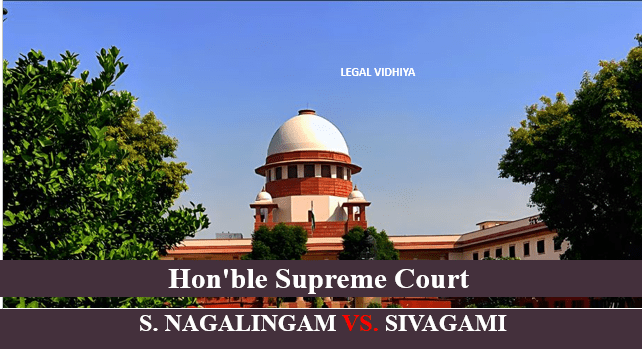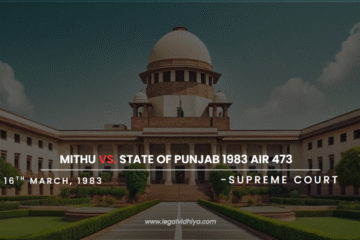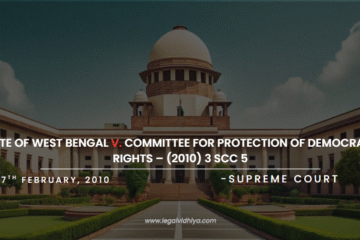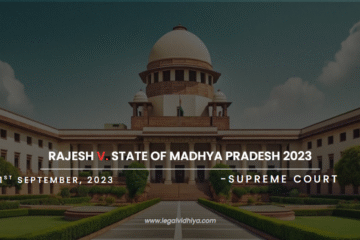
| CITATION | (2001) 7 SCC 487 |
| DATE OF JUDGMENT | 31 August 2001 |
| COURT | SUPREME COURT OF INDIA |
| APPELLANT | S. NAGALINGAM |
| RESPONDENT | SIVAGAMI |
| BENCH | D.P. MOHAPATRA & K.G. BALAKRISHNAN, J. |
LAWS/ LEGISLATIONS APPLICABLE
Hindu Marriage Act, 1955
Indian Penal Code, 18602
INTRODUCTION
In S Nagalingam v Sivagami, the respondent filed a criminal appeal before the High Court of Madras, claiming that the learned Metropolitan Magistrate’s decision was incorrect. The challenged judgment of the learned Single Judge, which said that the appellant committed the act punishable under Section 494 of the Indian Penal Code, is before the appropriate court.
FACTS OF THE CASE
- S. Nagalingam, the appellant, and Sivagami, the respondent, married on September 6, 1970. The marriage resulted in three children. Sivagami said that her husband, S. Nagalingam, mistreated and abused her on several occasions, causing her to go to live with her parents. During this time, she learned that her husband had married another lady named Kasturi on July 18, 1984. The festivities were held in a venue in Thiru Thani. Sivagami then filed a criminal complaint against her husband and six others with the Metropolitan Magistrate. The trial court acquitted all of the defendants.
- Dissatisfied, she filed Criminal Appeal No. 67 of 1992 before the Madras High Court. On November 1, 1996, the High Court affirmed the acquittal of six other persons who were charged with her husband. However, in the case of S. Nagalingam, the High Court remanded the case to the Trial Court and allowed the complainant to present proof that the marriage was solemnized.
- Following that, the priest accused of performing the ceremonies was arrested and cross-examined. In a decision dated March 4, 1999, the Metropolitan Magistrate acquitted the defendants. Unsatisfied, Sivagami filed Criminal Appeal No. 486 of 1999 before the Madras High Court. The court found the appellant guilty of bigamy under Section 494 of the IPC.
- S. Nagalingam then appealed the High Court of Madras’s decision to the Supreme Court of India for relief.
ISSUE RAISED
- Whether the appellant’s second marriage with the second accused, Kasturi, on 18.6.1984 a lawful marriage under the Hindu Marriage Act, 1955?
- Is “Saptapadi” a necessary rite for the celebration of a marriage?
- Whether the basic elements of the Section 494 crime have been met in this case?
CONTENTIONS OF APPELANT
The appellant’s attorney argued that because “Saptapadi,” a Hindu marriage requirement, was not fulfilled, the marriage was invalid.
CONTENTIONS OF RESPONDENT
The respondent, on the other hand, claimed that the “Saptapadi” ceremony was unnecessary under Section 7-A of the Hindu Marriage Act and that the second marriage was performed in accordance with the customs and norms relevant to both parties. The cross-examination with the priest verified the same.
RATIO DECIDENDI
- In this case, the appellant and his putative second wife are both residents of Tamil Nadu, and their marriage took place there.
- The State of Tamil Nadu has added a State Amendment to the Hindu Marriage Act, 1955, which applies to any marriage between two Hindus solemnized in the presence of family, friends, or other individuals. The fundamental point of this clause is that the presence of a priest is not required for a legitimate marriage.
- The witness testified that the bridegroom brought the “Thiru Mangalam” and tied it around the bride’s neck, that the garlands were exchanged, and that the father of the bride stated that he was giving his daughter to “Kanyathon” on behalf of and in the witness of “Agnidevi,” and that the acceptance of the same by the father of the bridegroom clearly shows that the marriage was performed according to the custom applicable to the parties.
- In response to question (1), it is possible to establish that the marriage between the accused and the claimed second wife was legitimate under Section 7A of the Hindu Marriage Act of 1955.
- Concerning question (2), they have maintained that “Homa” and “Saptapadi” are the two important rites that must be conducted in order for a marriage to be considered legal under Hindu law.
- Saptapadi was judged to be an important ritual for a legitimate marriage only when the parties recognized that it was an essential ceremony under the form of marriage applicable to them.
- Because the appellant had no such case that the “Saptapadi” was an important one among the members of the community to which they belong in the current case, the marriage between the appellant and the second accused, Kasturi, is to be recognized as legitimate under the personal law applicable to them.
- Concerning issue (3), the essential elements of the offense under Section 494 of the IPC are:
- The accused must have entered into the first marriage; the accused must have entered into a second marriage during the duration of his first marriage; both weddings must be legitimate in the sense that the requisite rituals controlling the parties must have been completed.
OBITER DICTA
- Customs is an important component of society. In general, customs are practices that have been practiced in a given group since time immemorial. Section 3 (a) of the Hindu Marriage Act defines custom as any regulation that has been consistently followed for a long time and has gained the force of law among the locals. Customs should not be irrational or in conflict with public policy.
- In the current case, the Supreme Court stated that it is not necessary for all ceremonies to be done by everyone in connection to the regulations applicable to weddings under the Hindu Marriage Act. The customs and rules pertaining to the marriage are taken into account.
JUDGEMENT
The ingredients listed in Section 494 of the IPC3 that are required for the commission of the offense are:
a. the accused’s first marriage must have been contracted/solemnized,
b. the accused contracted the second marriage while the first marriage was still valid, and
c. both marriages must be valid. That is, they should be solemnized in accordance with all applicable customs and regulations.
The Metropolitan Magistrate ruled that because an important and necessary rite known as “Saptapadi” was not conducted, the second marriage was illegal. The learned single judge of the High Court, in overturning the Magistrate’s decision, held that Section 7-A of the Hindu Marriage Act governs the parties and that “Saptapadi” is not required for a marriage to be considered valid, and thus S. Nagalingam is guilty of bigamy.
According to Sivagami’s complaint, the marriage was performed in accordance with Hindu law at RCC Mandapam in Thiru Thani. She also claimed that the priest’s (PW 3) testimony was thorough and that it should be taken into account. The lawyer for the appellant, on the other hand, stated that “Saptapadi is an important ritual and since that was not performed, marriage cannot be considered valid.”
Section 17 of the Hindu Marriage Act, 1955- Punishment for Bigamy states that “any marriage between two Hindus solemnized after the commencement of this Act is void if either party had a husband or wife living at the date of such marriage; and the provisions of sections 494 and 495 of the Indian Penal Code, 1860 (45 of 1860), shall apply accordingly.”
The state of Tamil Nadu incorporated Section 7-A into the State Amendment Act. It is a unique clause that allows for suyamariyathai and seerthiruththa weddings. In this instance, both parties to the second marriage, namely the accused, S. Nagalingam, and the second wife, Kasturi, are Tamil Nadu residents, and the marriage ceremony was held in the same state.
The following are the requirements for a legitimate marriage under this provision:
“7-A. Special provision for suyamariyathai and seerthiruththa marriages
- This section shall apply to any marriage between any two Hindus, whether called suyamariyathai marriage, seerthiruththa marriage, or by any other name, and solemnized in the presence of relatives, friends, or other persons-
(a) by each party to the marriage declaring in any language understood by the parties that each takes the other to be his wife or, as the case may be, her husband; or
(b) by each party to the marriage garlanding or putting a ring on any finger of the other; or
(c) by tying the thali.
(2) (a) Notwithstanding anything in section 7, but subject to the other provisions of this Act, all marriages solemnized after the commencement of the Hindu Marriage (2a [Tamil Nadu] Amendment) Act, 1967, shall be lawful and legal in law.”
CONCLUSION
This was a momentous decision since it supported the confidence of many women in the judiciary when their spouse marries again without cutting relations with the previous wife. In this decision, the Supreme Court transcended religious, customary, and ritualistic bounds to demonstrate that justice is supreme. The Supreme Court has often said that the Hindu Marriage Act’s rites and traditions are not exclusive, and if any customs are appropriate to the parties, the court would consider them to determine the legitimacy of the marriage.
There are various gaps in the bigamy regulations that the parties use, and they must be investigated.
REFERENCE
- https://indiankanoon.org
- https://dejurenexus.com
- https://lawplanet.in/s-nagalingam-v-sivagami-case-summary-2001
This case analysis is drafted by Bhoomi Sharma student of Lloyd Law College, CCS; an Intern at Legal Vidhiya.




0 Comments